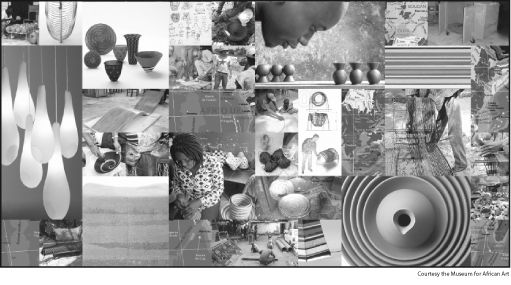By Laura Silver
Design Made in Africa
Museum for African Art at World Financial Center
Courtyard Gallery, 220 Vesey Street, Second Floor
Friday noon to 6:00 p.m., Saturday and Sunday 1:00 p.m. to 5:00 p.m.
Through June 24
(718-784-7718; africanart.org)
The Museum for African Art’s “Design Made in Africa” exhibition at the World Financial Center Courtyard Gallery is tricky to find, but worth the effort. (Look on the second floor above the food court and just behind the American Express Travel Service desk). One might say the same thing about African design.
The exhibition, which originated with a series of workshops in Dakar, Senegal four years ago, reminds viewers that common-sense solutions to everyday challenges know no boundaries. The 45 objects on display share a common geographical heritage — they were all conceptualized and created on the African continent by 31 designers from 14 African countries — and represent a broad spectrum of cultures, countries, materials and approaches to design problems. The show, organized by Parisian curators Michel Bouisson and Céline Savoye, presents decorative and functional items for the body, the home and the outdoor environment as diverse as the peoples and regions of Africa. Since its launch at the SIAO Ouagadougou Internal Craft Fair in Burkina Faso in 2004, the exhibition has traveled throughout Africa, Europe, Latin America and the United States with the hopes of cultivating new markets to help turn the prototypes into products and profits. But this is not envisioned as a one-way exchange. A poster-sized outline of the African continent with lines delineating the borders of unnamed countries challenges viewers to consider their basic knowledge of the continent’s geographic boundaries. (Don’t worry, there’s not a quiz.)
Humor, inventiveness and problem solving are the overarching themes.
Jules Bertram Wokam of Cameroon uses wood and steel to construct furniture inspired by traditional weaving. His recliner, whimsically titled “Dreadlocks,” stretches clothespin-sized bits of multicolored wood over a pair of N-shaped steel legs. Each row of wooden chunks is stitched together with a cord that is knotted and left to dangle on either side of the chair, to create a row of playful floor-length tresses.
South African Piet Pienaar riffs on the tradition of imprinting leaders faces on fabric in “Missing.” Instead of Nelson Mandela, his red and yellow cloth depicts soccer balls, and the black and white portrait of a student who, we learn from a closer look, is Zvidzai Muatarisi, 17 years old, phone number 086001011.
The works speak for themselves, but an installation of photographs and quotations from each of the designers is quite possibly the most intimate and engaging part of the exhibition. It introduces us to the people behind the innovation: Sanaa Gateja of Uganda who uses recycled newspaper to makes beads that are fashioned into substantive necklaces; Amira Atallaoui-Deverchère of Algeria whose ceramic vitavapeur provides an elegant and effective way to cook a tagine; Jean-Claude Ballonga of Congo who created a hand-held basket from a pair of grilles that house the blades of oscillating fans.
The show closes on Sunday, but one hopes that the objects will return to New York as items for sale, so we can make them our own.

































